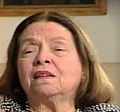Galicians
 Galician bagpipers | |
| Total population | |
|---|---|
c. 3.2 million[1]
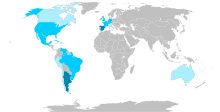 | |
| Regions with significant populations | |
| | |
| | 2,397,613[2][3] |
| Province of A Coruña | 991,588[2][3] |
| Province of Pontevedra | 833,205[2][3] |
| Province of Lugo | 300,419[2][3] |
| Province of Ourense | 272,401[2][3] |
| 355,063[2][3] | |
| 147,062[4] | |
| 38,440–46,882[4][5] | |
| 38,554[4] | |
| 35,369[4] | |
| 31,077[4] | |
| 30,737[4] | |
| 16,075[4] | |
| 14,172[4] | |
| 13,305[4] | |
| 10,755[4] | |
| 9,895[4] | |
| Galicians inscribed in the electoral census and living abroad combined (2013) | 414,650[4] |
| Languages | |
| Galician, Spanish | |
| Religion | |
| Roman Catholicism[6] | |
| Related ethnic groups | |
| Portuguese (particularly Norte), Asturians, Leonese people, other Spaniards, modern Celts | |
Galicians (
Etymology

The
The oldest known inscription referring to the Gallaeci (reading Ἔθνο[υς] Καλλαικῶ[ν], "people of the Gallaeci") was found in 1981 in the
The etymology of the name has been studied since the 7th century by authors such as
Another recent proposal comes from the linguist
Languages
Galician


Galician is a
Medieval or Old Galician, also known by linguists as
Galician-Portuguese diverged into two linguistic varieties – Galician and Portuguese – from the 15th century on. Galician became a regional spoken language under the influence of Castilian Spanish, while Portuguese became the international one, as language of the Portuguese Empire. The two varieties are still close together, and in particular northern Portuguese dialects share an important number of similarities with Galician ones.[25]
The official institution regulating the Galician language, backed by the Galician government and universities, the Royal Galician Academy, claims that modern Galician must be considered an independent Romance language belonging to the group of Ibero-Romance languages and having strong ties with Portuguese and its northern dialects.
However, the
Nowadays, despite the positive effects of official recognition of the Galician language, Galicia's socio-linguistic development has experienced the growing influence of Spanish and persistent linguistic erosion of Galician due to the media as well as legal imposition of Spanish in learning.
Galicia also boasts a rich oral tradition, in the form of songs, tales, and sayings, which has made a vital contribution to the spread and development of the Galician language. Still flourishing today, this tradition shares much with that of Portugal.
Surnames
Galician surnames,), among many others.
Because of the settlement of Galician
| English name | Old Galician (13-15th c.) | Modern Galician | Spanish |
|---|---|---|---|
| John | Eanes | Anes, Oanes, Yanes | Yáñez, Ibáñez |
| Stephen | Esteuaes, Esteuaez, Esteueez | Estévez | Estévanez |
| - | Froes, Froez | Fróiz, Frois | Flores, Flórez |
| Julian | Giançe, Gianz, Gians | Giance | Juliánez |
| Ermengild | Meendez, Meendes | Méndez | Menéndez, Meléndez |
| Martin | Martiiz | Martíns, Martís | Martínez |
| Michael | Migueez | Miguéns, Míguez | Miguélez |
| Pelagius | Paaez, Paaz | Páes, Paiz, Paz | Peláez |
| - | Veasques, Vaasquez | Vázquez | Velázquez, Blázquez |
| Benedict | Beeytez, Beeytes | Viéitez, Vieites | Benítez |

The largest surname group is the one derived from toponyms, which usually referred to the place of origin or residence of the bearer. These places can be European countries (as is the case in the surnames

A few of these toponymic surnames can be considered

The third group of surnames are the occupational ones, derived from the
The fourth group includes the surnames derived from nicknames, which can have very diverse motivations:
a) External appearance, as eye colour (Ruso, from Latin roscidus, grey-eyed; Garzo, blue-eyed), hair colour (Dourado, "Blonde"; Bermello, "Red"; Cerviño, literally "deer-like", "Tawny, Auburn"; Cao, "white"), complexion (Branco, "White"; Pardo, "Swarth"; Delgado, "Slender") or other characteristics: Formoso ("Handsome"), Tato ("Stutterer"), Forte ("Strong"), Calviño ("Bald"), Esquerdeiro ("Left-handed").
b) Temperament and personality: Bonome, Bonhome ("Goodman"), Fiúza ("Who can be trusted"), Guerreiro ("Warlike"), Cordo ("Judicious").
c) Tree names: Carballo ("Oak"); Amieiro, Ameneiro ("Alder"); Freijo ("Ash tree").
d) Animal names: Gerpe (from Serpe, "Serpent"); Falcón ("Falcon"); Baleato ("Young Whale"); Gato ("Cat"); Coello ("Rabbit"); Aguia ("Eagle")
e) Deeds: Romeu (a person who pilgrimaged to
Many Galician surnames have become
History
Prehistory

The oldest human occupation of Galicia dates to the
Later on, some 6,500 years ago, a
Some 4,500 years ago a new culture and population arrived and presumingly admixed with the local farmers, the
- Early Bronze Age
-
Outeiro do cribo ('sieve's hill') labyrinth
-
Castriño de Conxo, Bronze Age weaponry
-
Laxe dos Carballos, deer hunting with leaf-shaped spears and cup and ring marks
-
Casota de Freáns, Vimianzo, a Bronze Age megalith with no corridor or tumulus
-
Caldas de Reis hoard, one of the largest in Western Europe, circa 1,800 BCE
-
Interior of a Bronze Age cabin (recreation), Campo Lameiro
During the Late Bronze Age and until 800-600 BCE the contacts with both southern Spain to the south, and
This period and interchange network, usually known as
- Late Bronze Age
-
Late Bronze Age hoard of Samieira, unearthed in 1948 at some 50 metres from the seashore, and initially consisting of 152palstaves
-
Bronze Age Galician swords, Museo de Pontevedra
-
Pedra Alta warrior stelle, Castrelo do Val
-
1. sword and girdle. 3. v-notch shield. 4. cart with horses
-
Horned-helmet figures
-
A rider
The Bronze Age - Iron Age transition (locally 1000-600 BCE) coincides with the hoarding of large quantity of bronze axes, unused, both in Galicia,
These hill-forts were delimited usually by one or more walls; the defences also include ditches, ramparts and towers, and could define several habitable spaces. The gates were also heavily fortified. Inside, houses were originally built with perishable materials, with or without a stone
This culture is now known as
- Iron Age
-
Castromaior, Portomarín, Lugo
-
Castromaior's relief
-
Sauna of Punta dos Prados, Ortigueira
-
Sacrificial hatchet showing an ox, cauldron and torc
-
Short swords
-
Local ear pendants of ultimate Mediterranean origin
Occasional contacts with Mediterranean navigators, since the last half of the second millennium BCE,
Roman conquest
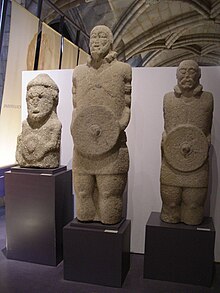
First recorded contact with Rome happened during the Second Punic War, when Gallaecians and Astures, together with Lusitanians, Cantabrians and Celtiberians —that is, the major Indo-European nations of Iberia— figured among the mercenary armies hired by Hannibal to go with him into Italy. According to Silus Italicus's Punica III:[58]
Fibrarum, et pennæ, divinarumque sagacem
Flammarum misit dives Callæcia pubem,
Barbara nunc patriis ululantem carmina linguis,
Nunc, pedis alterno percussa verbere terra,
Ad numerum resonas gaudentem plaudere cætras.
Hæc requies ludusque viris, ea sacra voluptas.
Cetera femineus peragit labor: addere sulco
Semina, et inpresso tellurem vertere aratro
Segne viris: quidquid duro sine Marte gerendum,
Callaici conjux obit inrequieta mariti.

"Opulent Galicia sent her youth, expert in divination through the entrails of beasts, the flight of birds and the divine lightnings; sometimes they delight to chant rude songs in their fatherland's tongues, other times they make the ground tremble with alternative foot while happily clashing their
After ending victoriously the
The Roman contact had a very large impact on the Castro Culture: an increase in commerce with the south and the Mediterranean; adoption or development of sculpture and stone carving; the
- Oppida and Roman conquest
-
Gates of the oppidum of Saint Cibrao de Las
-
Aerial photo of San Cibrao de Las
-
Santa Tregra, A Guarda
-
Santa Trega with the Minho in the background
-
As minted circa 20 BCE during the conquest of Galicia, Asturia and Cantabria
-
Equitation scene, Formigueiro, Amoeiro
In 61 BCE
Languages and ethnicity

Pomponius Mela (a geographer from Tingentera, modern day Algeciras in Andalusia) described, circa 43 CE, the coasts of northwestern Iberia:[66]
Frons illa aliquamdiu rectam ripam habet, dein modico flexu accepto mox paululum eminet, tum reducta iterum iterumque recto margine iacens ad promunturium quod Celticum vocamus extenditur.
Totam Celtici colunt, sed a Durio ad flexum Grovi, fluuntque per eos Avo, Celadus, Nebis, Minius et cui oblivionis cognomen est Limia. Flexus ipse Lambriacam urbem amplexus recipit fluvios Laeron et Ullam. Partem quae prominet Praesamarchi habitant, perque eos Tamaris et Sars flumina non longe orta decurrunt, Tamaris secundum Ebora portum, Sars iuxta turrem Augusti titulo memorabilem. Cetera super Tamarici Nerique incolunt in eo tractu ultimi. Hactenus enim ad occidentem versa litora pertinent.
Deinde ad septentriones toto latere terra convertitur a Celtico promunturio ad Pyrenaeum usque. Perpetua eius ora, nisi ubi modici recessus ac parva promunturia sunt, ad Cantabros paene recta est.
In ea primum Artabri sunt etiamnum Celticae gentis, deinde Astyres. In Artabris sinus ore angusto admissum mare non angusto ambitu excipiens Adrobricam urbem et quattuor amnium ostia incingit: duo etiam inter accolentis ignobilia sunt, per alia Ducanaris exit et Libyca
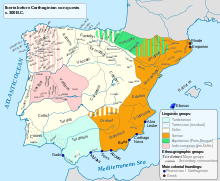
"That ocean front for some distance has a straight bank, then, having taken a slight bend, soon protrudes a little bit and then it is drawn back, and again and again; then, lying on a straight line, the coast extends to the promontory which we call Celtic. All of it is inhabited by Celtics, except from the Durio until the bend, where the Grovi dwelt —and through them flow the rivers Avo, Celadus, Nebis, Minius and Limia, also called Oblivio—. On the bend there is the city of Lambriaca and the receding part receives the rivers Laeros and Ulia. The prominent part is inhabited by the Praestamarci, and through them flow the rivers Tamaris and Sars —which are born not afar— Tamaris by harbour Ebora, Sars by the tower of Augustus, of memorable title. For the rest, the Supertamarici and Neri inhabit in the last tract. Up to here what belongs to the western coast. From there all the coast is turned to the north, from the Celtic promontory to the Pyrenees. Its regular coast, except where there are small retreats and small headlands, is almost straight by the Cantabrians. On it first of all are the Artabri, still a Celtic people, then the Astures. Among the Artabri there is a bay which lets the sea through a narrow mouth, and encircles, not in a narrow circuit, the city of Adrobrica and the mouth of four rivers." The Atlantic and northern coast of today's Galicia was inhabited by Celtic peoples, with the exception of the southern extreme. Others geographers and authors (Pliny, Strabo), as well as the local Latin epigraphy, confirm the presence of Celtic peoples.
As for the language or languages spoken by the Galicians previously to their romanization, most scholars usually perceive a primitive Indo-European layer, another later one hardly distinguishable from Celtic and identifiable with Lusitanian, most notable in the south, the Gallaecia Bracarense (as a result, Lusitanian is sometimes called Lusitanian-Gallaecian) and finally Celtic proper; as stated by Alberto J. Lorrio:[67] "the presence of Celtic elements in the Northwest is indisputable, but there is no unanimity in considering whether there was an only Indo-European language in the West of Iberia, of Celtic kind, or either a number of languages derived from the arrival of non-Celtic Indo-Europeans first, and Celts later on". Some academic positions on this issue:
- Palaeolithic continuity theory, considers that Celtic language is autochthonous in Galicia.[68] Since recent genetic studios show that European and Iberian Palaeolithic population was assimilated by larger migrant populations proceeding first from the Balkans and Anatolia, and later from Central Europe and ultimately from the Pontic steppe, this theory is probably flawed.
- For
- Joan Coromines, lexicographer and author of the Diccionario crítico etimológico castellano e hispánico, considered that Galician language had a very important substrate attributable to at least two different Indo-European languages, an older non Celtic one who he derived from the Urnfield people and thought was present in most of northern Iberia, and another one he named Artabrian, the Celtic language of the Celts of Galicia.
- Blanca M. Prósper
- Joaquín Gorrochategui, José M. Vallejo,[76] Alberto J. Lorrio, García Alonso,[77] E. Luján[78] and others, consider that Lusitanian is not a Celtic language, but they don't consider it closer to Italic, neither, but part of a group of IE dialects which later evolved into Celtic, Italic and Lusitanian. On the other hand, Celtic speakers lived in close proximity to the Lusitanian. In this context, Gallaecia Bracarensis was clearly in communion with the Lusitania,[79] while Gallaecia Lucensis had its own Celtic profile.[80][81][82][83][84]
- Jürgen Untermann, continued by his disciple Carlos Búa,[85] defended that along the westernmost part of Iberia there was essentially just one language or group of languages, Gallaecian-Lusitanian or Lusitanian and Gallaecian, which in their opinion was definitely Celtic and not Italoid, as shown by the ending of dative plural (-bo, -bor < PIE -*bhos) and the evolution of the syllabic consonants, in particular -r̥- > -ri-.
- Local scholars and researchers of toponymy and lexicon of pre-Latin origin (J. J. Moralejo, Edelmiro Bascuas) saw at least two layers of Indo-Europeans: one early layer of a very primitive IE language which preserved p, most notable in river names, and a later Celtic layer.[86][87]
Roman period
A common characteristic of both Gallaecians and western Astures were their onomastic formula and social structure: while most of the other Indo-European peoples of Hispania used a formula such as:
- Name + Patronimic (gen. s.) + Gens / Family (gen. pl.), as, for example,
- Turaesius Letondicum Marsi f(ilius) : 'Turaesius son of Marsi, of the Letondi clan'

Gallaecians and western Astures used, until the 2nd century of our era, the formula:[90]
- Name + Patronimic (gen. s.) + [Populi/Civitas] (nom. s.) + [⊃] (abreviature of castellum) Origo (abl. s.) as:
- Nicer Clvtosi ⊃ Cavriaca Principis Albionum : Nicer, son of Clutosios, from castle Cauria, prince of the Albion
- Caeleo Cadroiolonis f(ilius) Cilenus ⊃ Berisamo : Cailio, son of Cadroilo, Cilenus from castle Berisamo
- Fabia Eburi f(ilia) Lemava ⊃ Eritaeco : Fabia, daughter of Eburios, Lemava from castle Eritaico
- Eburia Calueni f(ilia) Celtica Sup(ertamarca) ⊃ Lubri : Eburia, daughter of Calugenos, Celtica Supertamarca from castle Lubris
- Anceitus Vacc[e]i f(ilius) limicus ⊃ Talabrig(a) : Anceitos, son of Vacceos, Limicus from castle Talabriga
The known personal names used by locals in northern Gallaecia were largely Celtic:[91] Aio, Alluquius, Ambatus, Ambollus, Andamus, Angetus, Arius, Artius, Atius, Atia, Boutius, Cadroiolo, Caeleo, Caluenus, Camalus, Cambauius, Celtiatus, Cloutaius, Cloutius, Clutamus, Clutosius, Coedus, Coemia, Coroturetis, Eburus, Eburia, Louesus, Medamus, Nantia, Nantius, Reburrus, Secoilia, Seguia, Talauius, Tridia, Vecius, Veroblius, Verotus, Vesuclotus, among others.
Three
Also, Gallaecia and Asturia became the most important producers of gold on the Empire: according to Pliny Lusitania, Gallaecia and, especially, Asturia, produced the equivalent to 6,700 kg per year. It has been estimated that the eight hundred Roman gold mines known in Galicia produced in total in between 190,000 and 2,000,000 kg.[94]
-
Reenactors at Lugo's Arde Lucus
-
Roman camp of Aquis Querquennis
-
Nicer Clutosi's stelle
-
Apana Amboli's stele
-
Tabula hospitalis from Carbedo
-
Romanized hill-fort of Viladonga, Castro de Rei
During the
Germanic era: 5th – 8th centuries
In 409 the
In 430 a long term conflict broke in between the Suebi and locals who chronicler Hydatius called gallaecos (i.e. galegos, the endonym of modern-day Galicians) and, initially, plebs ("folk, common people"), in contrast with whom he called romani: the rural landowners in Lusitania and the inhabitants of the cities. Soon, among those Galicians, appear also local noblemen and churchmen. As the Britons in southern Great Britain, the Galician were forced to act autonomously from Rome, exercising home rule.[97] They reoccupied old Iron Age hill-forts and built new strongholds and fortification all along Galicia;[98] the largest known today are at Mt. Pindo,[99] Mt. Aloia[100] and at Castro Valente.[101] These fortresses were later used by locals against Visigoths, Arabs and Norsemen. In this conflict in between Galicians and Suebi, Rome and local bishops acted frequently rather as intermediaries than as a part, and peace our truce was obtained or warranted with the interchange of prisoners and hostages.[95][102]
In 438 both people attained a peace that would last for twenty years; by then old king
The chronicle of Hydatius also records naval raids of both Vandals and Heruli on the Galician coasts during the 5th century.[95]
Medieval era
In 718 the area briefly came under the control of the Moors after their conquest and dismantling of the Visigothic Empire, but the Galicians successfully rebelled against Moorish rule in 739, establishing a renewed Kingdom of Galicia which would become totally stable after 813 with the medieval popularization of the "Way of St James".
Geography and demographics
Political and administrative divisions
The autonomous community, a concept established in the
Population, main cities and languages
The official statistical body of Galicia is the Instituto Galego de Estatística (IGE). According to the IGE, Galicia's total population in 2008 was 2,783,100 (1,138,474 in A Coruña,[104] 355.406 in Lugo,[105] 336.002 in Ourense,[106] and 953.218 in Pontevedra[107]). The most important cities in this region, which serve as the provinces' administrative centres, are Vigo (in Pontevedra), Pontevedra, Santiago de Compostela, A Coruña, Ferrol (in A Coruña), Lugo (in Lugo), and Ourense (in Ourense). The official languages are Galician and Spanish. Knowledge of Spanish is compulsory according to the Spanish constitution and virtually universal. Knowledge of Galician, after declining for many years owing to the pressure of Spanish and official persecution, is again on the rise due to favorable official language policies and popular support.[citation needed] Currently about 82% of Galicia's population can speak Galician[108] and about 61% have it as a mother tongue.[10]
Culture
Celtic revival and Celtic identity

In the 19th century a group of
As a Celtic region of Spain, Galicia has a tartan called Galicia National.[120]
During the late 19th and early 20th century this revival permeated Galician society: in 1916

From the 1970s on a series of Celtic music and cultural festivals were also popularized, the most notable being the Festival Internacional do Mundo Celta de Ortigueira, at the same time that Galician folk musical bands and interpreters became usual participants in Celtic festivals elsewhere, as in the Interceltic festival of Lorient, where Galicia sent its first delegation in 1976.[123]
- Celtic and non Celtic elements common along the western Atlantic coast of Europe which are popularly perceived as Celtic.
-
A castro (hill-fort) at Baroña, Porto do Son
-
Medieval interlaced cross, Santiago de Compostela
-
Triskelion from the Museo de Ourense
-
View of the hillfort at San Cibrao de Las, Ourense
-
The rocky and misty coast of Cabo Silleiro, Baiona
Folklore and traditions

Myths and legends




Galician
- Before the world was inhabited by humans, animals could speak: many traditional tales about animals begin with the phrase aló cando os animais falaban, 'back then, when animals used to speak', which has become equivalent to English once upon a time.
- Our world is connected to an hill-forts, etc., which are still traditionally called with names such as Eira dos Mouros ('Mouros' threshing floor'), Casa dos Mouros ('Mouros' house'), Forno dos Mouros ('Mouros' oven'). This kind of place names are already attested in Latin documents dating to circa 900 CE and later. Humans can also travel to the underworld, either becoming very rich or suffering for their greed as a result. Some mouros or encantos can appear as tall and strong men riding large horses and there are specific spells to ask them for riches.
- dianas). They are frequently portrayed as women of incredible beauty and riches and long golden blonde hair that can be found by the aforementioned prehistoric ruins or at fountains and ponds, where they comb their hair. Other times, they are gigantic women of incredible strength, enough to move massive boulders, who can be found with a spinning distaff or a baby.[125] Under this appearance they are the same with the Vella ("the Old Lady"), who is somehow also responsible for the weather: the rainbow is called arco da vella in Galician ("Old Lady's bow"), a myth which is probably related to the Cailleach, 'Old Woman', 'Hag', of Ireland and Scotland.[126]
- Lavandeiras (washerwomen) are eerie fairies that are found at a river of pond washing clothes, under the aspect of women, especially at night. They can ask a passer-by to help twits the clothes: if the passer-by mistakenly twists in the same direction, the clothes turn into blood.[124]
- The nightmaresby siting on the chest of the people, move things and cause other troubles. In Galician trasnada (~'goblin-ery') means 'trick, mischief'.
- Other sign of the netherworld is the apparition of a golden hen followed by his golden chicks (a galiña dos pitos de ouro), which, no matter how hard one tries, can't be caught. There is a similar myth in Bulgaria.
- Maruxaina was a vicious siren who lived near the town of San Cribrao and who eventually was captured and executed by the locals.
- The barrows are also inhabited by other entities called ouvas ('elfs').
- Other beings with control of the weather are the nubeiros ('cloud-ers'). George Borrow in his book The Bible in Spain narrates how he met a nubeiro while travelling Galicia circa 1835.[127] Other similar beings are the tronantes and escoleres.
- Many lakes are believed to be the result of the drowning of ancient cities (frequently called Lucerna, Valverde, 'Green Valley', or Antiochia in tales and legends) when the inhabitants failed to give shelter to Jesus or a saint, or when a king of the mouros used his magic out of spit. Some nights the city's bells can still be heard.[124] This legend was first recorded in the 12th century Codex Calixtinus and in that version is Charlemagne who prays God and Saint James to drown a Moor city reluctant to commit to him.[128] This myth appear to be related to the Breton myth of Ys.
- Another mythical being associated with drowned cities is the boi bruador, a bellowing ox which can be heard at night near lakes, a legend first recorded circa 1550.[124]
- Olláparos are giants similar to cyclopes who sometimes have also an eye on the back of the head.[124] They are related to the Cantabrian Ojáncanu.
- Bruxas and meigas (anaemia.
- Lobishomes (werewolves) are humans who sometimes turn into wolves because of a curse.[129] Manuel Blanco Romasanta was a Galician serial killer sentenced to death in 1853 for thirteen assassinations. His legal defence was based in his condition of werewolf as consequence of a curse.[130]
- Anciently, there were giant Holy land to Galicia, recorded in the 12th century Codex Calixtinus, the local queen, Queen Lupa, commanded the disciples of Saint James to go grab a pair of meek oxen she had by the hill known as Pico Sacro ("Sacred Peak"), where a dragon dwelt, with the hope that either the dragon or the oxen (which were actually fierce bulls) would kill them.[128] There were also cocas (cockatrices), which were taken out in procession in certain dates, as attested since 1437.[124] In the town of Redondelathis procession is still held each year.

- The compaña ('retinue'), hoste ('army'), estantiga ( < hoste antiga, 'anciente army'), wild hunt. In its modern form is a nocturne procession of the dead, who, porting candles or torches, and frequently a coffin, announce the imminent decease of a neighbour. This procession can "capture" a living person, who is then obliged to precede the Santa Compaña all night long, through forest, streams and brambles, or until another one takes his place. One can protect himself from being taken by the Compaña by tracing a circle and getting inside it, or by throwing oneself to the ground and ignoring the Compaña while it passes over. A solitary phantom related to the Compaña is the estadea. This myth is also related to the fairy host in Ireland, sluagh in Scotland and toili in Wales.[115]
- The urco (güercu in Asturias) is a giant black dog who emerges from the sea or from a river to cause terror to the locals. They are also, per se, a bad omen.[131]
Traditions and beliefs
While Galician was traditionally a profoundly Catholic society, in its beliefs there are many remnants of previous religious systems, in particular the belief on a pantheon of gods, now saints; in the reincarnation in form of an animal, when there are unfinished business; the evil eye and the sickness caused by curses; the holiness of crossroads and fountains, etcetera. The first attestation of the beliefs of the Galicians in a Christian context is offered by the Pannonian Martin of Braga who in his letter De Correctione Rusticorum condemns, among others, the belief in the Roman gods or in the lamias, nymphs and dianas, and also in practices as putting candles to trees, springs and crossroads.
- Sanctuaries are socially important places for pilgrimage (romaría) and devotion, each one under the protection of a saint or virgin Mary. There are different beliefs associated with each one: the sanctuary of Santo André de Teixido in Cedeira is associated with reincarnation, as it is said that a Santo André de Teixido vai de morto o que non foi de vivo ('to Saint Andrew at Teixido —yew-tree-copse— goes as dead the ones that didn't went while alive'). It is advised not to kill lizards or any other animal while in the vicinity. The Corpiño sanctuary near Lalín and San Campío near Tomiño are associated with the treatment of mental illness and evil eye or meigallo. Virxe da Barca in Muxía is built by the place where it is said that Mary arrived aboard a stone boat, a recurring myth in Galicia also present in Ireland and Brittany.[132]Many of these places were probably built over pagan cult places.
- High crosses and calvaries, locally named cruceiros or peto de ánimas, are usually placed at crossroads, before sacred places, or marking a pilgrimage road. Placing flowers or lit candles before that monuments are common practices. In 1996 the Galician community in Ushuaia, Argentine, the southernmost city on the world, built a cruceiro with the legent 'Galicia shines in this land's end'.
- Sanctuaries, cruceiros and petos de ánimas
-
Virxe da Barca, Muxía
-
Santo André de Teixido, Cedeira
-
Peto de ánimas, crossroad of Moldes, Pobra do Caramiñal
-
Calvario at Castro Barbudo, Ponte Caldelas
-
Cruceiro do Hío,Cangas do Morrazo
-
Cruceiro at Muros
- Traditional medicine was administered by menciñeiros and menciñeiras, who used both herbs and spells to treat illness. Also compoñedores and compoñedoras: healers specialized in mending bones and joints.
Popular feasts
Aside from Catholic feasts and celebrations, there are other annual celebrations of pagan or mixed origin:
- Entroido (Ourense, maskssuch as the peliqueiros, cigarróns, boteiros, felos, pantallas, who can commit minor mischiefs to other attendants, are central to the celebrations.
- Noite de San Xoán (Saint John's eve). Saint John's eve is celebrated around bonfires which are lit at dusk; young people jump over the fire three, seven or nine times. Other traditions associated to this night is the nine-waves bath in the beach, for having children,[133] and the preparation of the auga de San Xoán (Saint John's water) by letting a bowl with a mixture of selected herbs outdoors all night. This water is used to wash one's face in the morning.
- Rapa das bestas.
- Feasts
-
Entroido: Peliqueiros of Laza, Ourense
-
Boteiros, Viana do Bolo
-
Traditional filloas, crepe-like pancakes
-
Pantallas from Xinzo de Limia
-
Carantoñas, Chantada
-
San Xoán
-
Aloitadores, Rapa das bestas
Traditional costume
Traditional Galician costume, as understood today, got conformed fundamentally during the second half of the 18th century. Notwithstanding, some very characteristic elements, as the monteira (an embroidered felt hat),
- Men's traditional costume
-
Musicians, c. 1900
-
A Galician, 1874
-
A bagpiper with monteira (hat)
-
An old man in traditional attire
-
Zocas
-
Polainas
Female costume was composed of cofia (coif) or, later, pano (headcloth); dengue (short cape worn as a jacket) or corpiño (bodice); camisa (shirt), refaixo (petticoat), saia (skirt), mantelo (apron) and faltriqueira (pouch or bag).[134]
- Women's traditional costume
-
Old lady with cofia
-
Galician woman with embroidered mantelo and saffron faldriqueira
-
Galician woman by Serafín Avendaño, 1891. She's wearing a dengue
-
Dancing
-
Zocos
-
At Pontevedra
-
Going to the fountain by Alfredo Souto Cuero, 1893.
Traditional music
The most characteristic instruments in traditional music is probably the gaita (bagpipe). The gaita have a conical double-reed chanter, and usually have one to four drones.[135] The bag is usually inflated through a blowpipe, but in the gaita de barquín it is inflated by the operation of a bellows. In the past the gaita was usually accompanied just by tamboril (snare drum) and bombo or caixa (bass drum), but since the middle of the twentieth century the groups and bands have become very popular. Pieces which are usually interpreted with gaita are the muiñeira, often in 6
8 time and very similar to Irish jigs;[136] the alborada, played during the early mornings of holydays; the marcha (march) which accompanies processions and retinues. Some renowned compositions are the 19th century Muiñeira de Chantada and the traditional Aires de Pontevedra (an alborada) and Marcha do Antigo Reino de Galicia (March of the Old Kingdom of Galicia).
Another very representative instrument is the pandeireta (tambourine), which along or together with other drums as the pandeiro, castanets, etc., usually accompanied the songs and celebrations of the working women and men during the seráns (evenings), foliadas or fiadas.
Other genres include de alalá, which can be sung a cappella, or the cancións de cego (blindman's songs), interpreted with violin of zanfoña.
- Galician musics and dancers
-
Bagpiper with a gaita de barquín and musicians with a pandeireta and tamboril
-
circa 1900: famous piper O Rilo
-
Bagpiper, 13th century, Cantigas de Santa Maria
-
Dancing a muiñeira
-
1927: Os gaiteiros de Soutelo
-
Musician Faustino Santalices
-
Pandereiteiras de Mens
Literature
-
Rosalia de Castro was one of the most representatives authors of the Rexurdimento(revival of the Galician language).
-
Eduardo Pondal, considered himself a "bard of freedom", he imagined a Celtic past of freedom and independence, which he tried to recover for Galicia with his poetry.[137]
-
Spanish Monarchyas well.
-
Manuel Rivas was born in A Coruña. A famous Galician journalist, writer and poet whose work is the most widely translated in the history of Galician literature.
Painting, plastic arts and architecture
-
Painter Luís Seoane
-
Sculptor Francisco Asorey
-
Architect Antonio Palacios
Science
-
Benito Jerónimo Feijóo y Montenegro was a monk and scholar who wrote a great collection of essays that cover a range of subjects, from natural history and the then known sciences.
-
Martin Sarmiento. He wrote on a wide variety of subjects, including Literature, Medicine, Botany, Ethnography, History, Theology, Linguistics, etc.
Music
-
culture, and women's empowerment.
-
Carlos Núñez is currently one of the most famous Galician bagpipers, who has collaborated with Ry Cooder, Sharon Shannon, Sinéad O'Connor, The Chieftains, Altan among others.
-
Susana Seivane is a Galician bagpiper. She was born into a family of well-known Galician luthiers and musicians (The Seivane).
-
Carlos Jean is a DJ and record producer. He was born in Ferrol, of Haitian and Galician heritage.
Sport
-
Francisco Javier Gómez Noya (1983-), former triathlete, Silver in 2012 Summer Olympics.
-
Óscar Pereiro is a professional road bicycle racer. Pereiro won the 2006 Tour de France.
-
David Cal Figueroais a Galician sprint canoer who has competed since 1999, he became the athlete with the most Olympic medals of all time in Spain.
-
Ana Peleteiro is a triple jumper and the current national record holder. She won the gold medal in the 2019 European Athletics Indoor Championships.[138]
Cinema and TV
-
María Castro (1981-) is a well-known Galician actress who performed in several Spanish TV series and movies.
-
Luis Tosar has starred in some successful Spanish movies such as Celda 211 or Te doy mis ojos.
-
Oliver Laxe is a French-born Galician director whose third film, Fire Will Come, became the most watched and most successful Galician film in history.
-
Maria Casarèswas one of the most distinguished stars of the French stage and cinema
People of Galician origin
-
Cuban former leader Fidel Castro
-
Caudillo and dictator of Spain, Francisco Franco
-
Portuguese explorer João da Nova
-
American actor Martin Sheen, born Ramón Estévez
-
Brazilian writer Nélida Piñon
-
Argentinian ex-president Raúl Alfonsín
-
José Alonso y Trelles, Uruguayan poet
-
Laurentino Cortizo Cohen, president of Panama
-
Tabaré Vázquez, ex-president of Uruguay
-
Mariano Rajoy, former Prime Minister of Spain
-
ORGA's founder and former Prime Minister of Spain
See also
- List of Galician people
- Galician nationalism
- Fillos de Galicia
- Galician diaspora
- Spanish people
- Nationalities and regions of Spain
References
- ^ Sum of the inhabitants of Spain born in Galicia (c. 2.8 million), plus Spaniards living abroad and inscribed in the electoral census (CERA) as electors in one of the four Galician constituencies.
- ^ a b c d e f g Not including Galicians born outside Galicia
- ^ a b c d e f g "Instituto Nacional de Estadística". Ine.es. Archived from the original on 3 March 2016. Retrieved 4 February 2016.
- ^ a b c d e f g h i j k l "INE – CensoElectoral". Ine.es. Archived from the original on 8 August 2022. Retrieved 4 February 2016.
- ^ Internacional, La Región (30 July 2015). "Miranda visita Venezuela para conocer las preocupaciones de la diáspora gallega". La Región Internacional. Archived from the original on 3 July 2017. Retrieved 12 December 2017.
- ^ "Interactivo: Creencias y prácticas religiosas en España". Lavanguardia.com. 2 April 2015. Archived from the original on 4 April 2015. Retrieved 12 December 2017.
- ISBN 0-313-30984-1. Archivedfrom the original on 16 January 2023. Retrieved 3 September 2019.
other Celtic peoples ... Galicians ...; ... Romance (Latin) nations ... Galicians
- PMID 30710075.
- ISBN 978-84-370-2895-8.
- ^ a b "Persoas segundo a lingua na que falan habitualmente. Ano 2003". Ige.eu. Archived from the original on 3 March 2016. Retrieved 4 February 2016.
- ISBN 978-1-85109-440-0.
- ISBN 978-0-9557182-3-6. Archivedfrom the original on 26 March 2023. Retrieved 19 July 2021., s.v. Callaeci.
- from the original on 30 January 2022. Retrieved 18 January 2022.
- ^ ISBN 978-84-95892-68-3. Archived(PDF) from the original on 22 March 2011. Retrieved 24 April 2013.
- ^ "9.17. Title for image of people of the Callaeci". IAph. Archived from the original on 18 June 2016. Retrieved 14 February 2021.
- ISBN 978-84-17595-07-4. Archivedfrom the original on 16 July 2021. Retrieved 16 July 2021.
- ^ Curchin, Leonard A. (2008) Estudios Gallegos The toponyms of the Roman Galicia: New Study Archived June 25, 2017, at the Wayback Machine. CUADERNOS DE ESTUDIOS GALLEGOS LV (121) p. 111
- ^ Benozzo, F. (2018) Uma paisagem atlântica pré-histórica. Etnogénese e etno-filologia paleo-mesolítica das tradições galega e portuguesa, in proceedings of Jornadas das Letras Galego-Portuguesas 2015–2017, DTS, Università di Bologna and Academia Galega da Língua Portuguesa, pp. 159-170.
- ^ Pierre-Yves Lambert, Histoire de la langue gauloise, éditions Errance, 1994, p. 99 - 194
- ^ a b LAMBERT 191
- ^ Xavier Delamarre, Dictionnaire de la langue gauloise, Errance, 2003, p. 98-99
- ^ DELAMARRE 98 - 99
- ^ Fernando Cabeza Quiles, Toponimia de Galicia, Editorial Galaxia, 2008, p. 301 - 302 - 303 (read online in Galician)[1] Archived 22 November 2023 at the Wayback Machine
- ^ "Galician". Ethnologue. Archived from the original on 28 March 2008. Retrieved 4 February 2016.
- ^ a b de Azevedo Maia, Clarinda (1986). História do Galego-Português. Estado linguistico da Galiza e do Noroeste de Portugal desde o século XIII ao século XVI. Coimbra: Instituto Nacional de Investigação Científica.
- from the original on 14 February 2022. Retrieved 14 February 2022.
- ^ Cf. Ana Isabel Boullón Agrelo / Xulio Sousa Fernández (dirs.): dos apelidos de Galicia[permanent dead link]. Santiago de Compostela: Instituto da Lingua Galega.
- OCLC 21951323.
- ISBN 84-7824-333-X.
- ISBN 84-7824-333-X.
- S2CID 76663708.
- PMID 32457149.
- ISBN 978-84-9121-048-1. Archivedfrom the original on 12 February 2022. Retrieved 12 February 2022.
- ^ Benozzo, F. (2018): "Uma paisagem atlântica pré-histórica. Etnogénese e etno-filologia paleo-mesolítica das tradições galega e portuguesa", in proceedings of Jornadas das Letras Galego-Portugesas 2015–2017. Università de Bologna, DTS and Academia Galega da Língua Portuguesa. pp. 159-170
- ISBN 978-0-300-11923-7.
- ISBN 978-1-84217-529-3.
- ISBN 978-84-96203-29-7.)
{{cite book}}: CS1 maint: location missing publisher (link - ISBN 978-0-203-44699-7. Retrieved 16 January 2022.
- ^ Cunliffe, Barry (1999). "Atlantic Sea-ways". Revista de Guimarães. especial - Actas do Congresso de Proto-História Europeia: 93–105. Archived from the original on 12 February 2022. Retrieved 12 February 2022.
- ^ Rodríguez, Ana (26 December 2021). "Henges, círculos invisibles de la Edad de Bronce". Faro de Vigo. Archived from the original on 15 February 2022. Retrieved 13 February 2022.
- ^ a b An Alternative to 'Celtic from the East' and 'Celtic from the West', Patrick Sims-Williams, Cambridge University Press, 2020 [2] Archived January 12, 2022, at the Wayback Machine
- PMID 34937049.
- hdl:10261/237815. Archivedfrom the original on 13 February 2022. Retrieved 13 February 2022.
- ^ Nigrán (16 February 2019). "El castro de Chandebrito duró mil años". Faro de Vigo. Archived from the original on 12 February 2022. Retrieved 12 February 2022.
- ^ Redacción (23 December 2021). "Penas do Castelo, un dos castros máis antigos de Galicia". GCiencia. Archived from the original on 12 February 2022. Retrieved 12 February 2022.
- ^ Nión-Álvarez, Samuel (2016). "Punta de Muros y su excepcionalidad en el contexto del Hierro I en el Noroeste peninsular". IX Jornadas de Jóvenes en Investigación Arqueológica. Santander. Archived from the original on 11 May 2022. Retrieved 15 February 2022.
- ^ Cano Pan, Juan A. (2010). "El yacimiento de Punta de Muros". Anuario Brigantino. 33: 33–63.
- S2CID 240654014.
- from the original on 15 February 2022. Retrieved 15 February 2022.
- )
- from the original on 2 March 2022. Retrieved 21 February 2022.
- ISBN 978-963-8046-72-7. Archivedfrom the original on 2 March 2022. Retrieved 2 March 2022.
- from the original on 2 March 2022. Retrieved 2 March 2022.
- S2CID 214517194.
- ISSN 0212-078X.
- ISBN 978-84-17729-31-8.
- ISBN 978-84-88301-13-0. Archivedfrom the original on 17 February 2022. Retrieved 17 February 2022.
- ^ OCLC 28499276.
- ^ "The dating of the Lomba do Mouro site makes it the largest and oldest Roman camp in Galicia and northern Portugal – The Roman Army in the NW of Hispania". 2 June 2021. Archived from the original on 20 February 2022. Retrieved 20 February 2022.
- OCLC 758056842.
- from the original on 21 February 2022. Retrieved 21 February 2022.
- OCLC 28499276.
- S2CID 240599598.
- from the original on 22 November 2023. Retrieved 18 January 2022.
- ^ culturagalega.org (11 December 2017). "Un arco de triunfo en Francia pode gardar a primeira representación dun guerreiro galaico vencido". culturagalega.org. Archived from the original on 22 November 2023. Retrieved 20 February 2022.
- ISBN 978-84-505-7380-0. Archivedfrom the original on 28 February 2022.
- ISBN 978-84-15038-26-9.
- ^ Galicia and North Portugal are the origin of European celticity Archived August 9, 2018, at the Wayback Machine, interview with Prof. Francesco Benozzo, 13/03/2016
- ISBN 978-1-84217-475-3.
- ISBN 978-1-84217-529-3.
- ISBN 978-1-78570-227-3.
- ISBN 978-84-7800-335-8. Archivedfrom the original on 13 February 2022. Retrieved 19 January 2022.
- ISBN 978-84-7800-818-6.
- ISBN 978-84-7800-818-6.
- ISBN 978-84-7800-335-8. Archivedfrom the original on 13 February 2022. Retrieved 19 January 2022.
- from the original on 1 March 2022. Retrieved 21 February 2022.
- ^ García Alonso, Juan Luis (1 January 2011). "Oclusivas aspiradas, celtas y lusitanos". A Greek Man in the Iberian Street, Festschrift Javier de Hoz, Juan Luis García Alonso y Eugenio Luján Martínez eds., Innsbruck, pp. 175-190. Archived from the original on 11 May 2022. Retrieved 25 February 2022.
- ISBN 978-0-19-879082-2. Archivedfrom the original on 25 January 2022. Retrieved 23 January 2022.
- ^ "Hesperia: Banco de datos de Lenguas paleohispanicas (read online)". Archived from the original on 28 November 2021. Retrieved 21 January 2022.
- ISBN 978-0-19-879082-2. Archivedfrom the original on 14 February 2022. Retrieved 23 January 2022.
- ISBN 978-84-7800-335-8. Archivedfrom the original on 11 February 2022. Retrieved 18 January 2022.
- from the original on 30 January 2022. Retrieved 18 January 2022.
- from the original on 1 March 2022. Retrieved 21 February 2022.
- ISSN 1540-4889.
- ISBN 978-84-17595-07-4. Archivedfrom the original on 1 March 2022. Retrieved 19 July 2021.
- ^ Bascuas, Edelmiro (2008). "la hidronimia de galicia. Tres estratos: paleoeuropeo, celta y latino" (PDF). Estudios Mindonienses. 24: 521–550. Archived (PDF) from the original on 3 January 2022. Retrieved 18 January 2022.
- ISBN 978-84-95892-68-3.
- from the original on 2 March 2022. Retrieved 2 March 2022.
- ISBN 978-84-17595-07-4. Archivedfrom the original on 1 March 2022. Retrieved 19 July 2021.
- ISBN 978-84-9750-794-3.
- ISBN 978-2-87772-350-3.
- ISBN 978-84-16343-39-3.
- ISBN 978-1-4073-1121-0. Archivedfrom the original on 22 November 2023. Retrieved 24 February 2022.
- ^ "Descubren en un municipio de Pontevedra la mina de oro subterránea romana más grande de Galicia". Público. A Coruña. 3 September 2021. Archived from the original on 24 February 2022. Retrieved 24 February 2022.
- ^ ISBN 978-84-96011-32-8.
- ISBN 978-84-16643-11-0.)
{{cite book}}: CS1 maint: others (link - ISBN 84-00-07215-4..
- hdl:10347/18729. Archivedfrom the original on 25 July 2023. Retrieved 19 January 2022.
- ^ "No corazón do xigante (e III): a Terceira Fortaleza do Pindo – Capítulo 0" (in Galician). Archived from the original on 25 July 2023. Retrieved 25 July 2023.
- S2CID 213442091. Archived from the originalon 25 July 2023. Retrieved 17 November 2022.
- from the original on 25 July 2023. Retrieved 25 July 2023.
- ^ Arias, Jorge C. (2007). "Identity and interaction: The Suevi and the Hispano-Romans" (Document). University of Virginia.
- ^ ISBN 9788446028505.
- ^ "IGE – Principais resultados". Ige.eu. Archived from the original on 24 March 2016. Retrieved 4 February 2016.
- ^ "IGE – Principais resultados". Ige.eu. Archived from the original on 24 March 2016. Retrieved 4 February 2016.
- ^ "IGE – Principais resultados". Ige.eu. Archived from the original on 24 March 2016. Retrieved 4 February 2016.
- ^ "IGE – Principais resultados". Ige.eu. Archived from the original on 24 March 2016. Retrieved 4 February 2016.
- ^ "Persoas segundo o grao de entendemento do galego falado. Distribución segundo o sexo. Ano 2003". Ige.eu. Archived from the original on 3 March 2016. Retrieved 4 February 2016.
- ISBN 978-84-460-2260-2.
- ^ García Quintela, Marco V (2005). "Celtic Elements in Northwestern Spain in Pre-Roman times". E-Keltoi: Journal of Interdisciplinary Celtic Studies. 6: 74.
- ISBN 978-84-7800-335-8. Archivedfrom the original on 11 February 2022. Retrieved 18 January 2022.
- ISBN 1-85109-445-8.
- ^ González-Ruibal, Alfredo (20 December 2004). "Artistic Expression and Material Culture in Celtic Gallaecia". E-Keltoi. 6: 113–166.
- ^ García Quintela, Marco V. (10 August 2005). "Celtic Elements in Northwestern Spain in Pre-Roman times" (PDF). E-Keltoi. 6: 497–569. Archived from the original (PDF) on 31 January 2015. Retrieved 10 May 2014.
- ^ from the original on 15 February 2022. Retrieved 19 January 2022.
- ^ Alberro, Manuel (6 January 2008). "Celtic Legacy in Galicia" (PDF). E-Keltoi. 6: 1005–1034. Archived from the original (PDF) on 24 June 2011. Retrieved 10 May 2014.
- ^ Wood, Walter; Mason, Frank H. (Frank Henry) (1910). A corner of Spain. London, E. Nash. Retrieved 16 February 2022.
- ^ Bell, Aubrey F. G. (Aubrey Fitz Gerald) (1922). Spanish Galicia. London, John Lane. Retrieved 16 February 2022.
- ^ Meakin, Annette M. B. (1909). Galicia, The Switzerland of Spain. London : Methuen & Co. Retrieved 16 February 2022.
- ^ "Tartan Details - the Scottish Register of Tartans". Archived from the original on 13 June 2023. Retrieved 12 November 2023.
- ^ "Galegos, sede fortes / prontos a grandes feitos / aparellade os peitos / a glorioso afán / fillos dos nobres celtas / fortes e peregrinos / luitade plos destinos / dos eidos de Breogán" Cf. "Himno Gallego". Archived from the original on 14 March 2015. Retrieved 10 May 2014.
- ISBN 978-84-460-2260-2.
- ISBN 978-2-7373-5223-2.
- ^ ISBN 978-84-9865-387-8.
- ^ "O PAÍS DA MOURA". YouTube. Archived from the original on 19 February 2022. Retrieved 19 February 2022.
- ISBN 978-84-8302-363-1. Archivedfrom the original on 18 February 2022. Retrieved 18 February 2022.
- ^ "—Ha, ha! I know him. He ran with me to this fountain, where he has just left me. That man, Sir Cavalier, is no thief. If he is any thing at all, he is a Nuveiro,—a fellow who rides upon the clouds, and is occasionally whisked away by a gust of wind. Should you ever travel with that man again, never allow him more than one glass of anise at a time, or he will infallibly mount into the clouds and leave you, and then he will ride and run till he comes to a water brook, or knocks his head against a fountain—then one draught, and he is himself again." George Borrow (1923). The Bible In Spain. John Murray. p. 420. Retrieved 18 February 2022.
- ^ )
- )
- ^ Ferro-Veiga, José Manuel (2020). El Hombre Lobo de Allariz: Manual Operativo de investigación de asesinos en serie. José Manuel Ferro Veiga.
- ^ "Urco, el terrorífico perro de Cortegada". La Voz de Galicia. 15 June 2014. Archived from the original on 18 February 2022. Retrieved 18 February 2022.
- from the original on 19 February 2022. Retrieved 19 February 2022.
- from the original on 20 February 2022. Retrieved 19 January 2022.
- ^ ISBN 978-84-15078-36-4.
- ^ "Os Instrumentos Musicais na Tradición Galega » Gaita de fol "sinxela"". Archived from the original on 17 April 2013. Retrieved 7 March 2022.
- ISBN 978-1-135-20414-3.
- ISBN 0-521-04313-1.
- European Athletics. 3 March 2019. Archivedfrom the original on 31 May 2019. Retrieved 11 March 2021.
External links
- Galician Portal
- A collaborative study of the EDNAP group regarding Y-chromosome binary polymorphism analysis
- Galician language portal
- Galician Music, Culture and History
- Galician Government
- Galician History and Language
- Santiago Tourism
- Page about The Way of St James
- Official page about The Way of St James
- Arquivo do Galego Oral – An archive of records of Galician speakers.
- A Nosa Fala – Sound recordings of the different dialects of the Galician language.

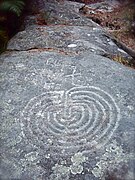

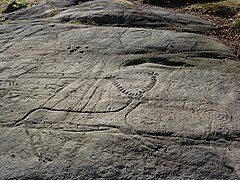

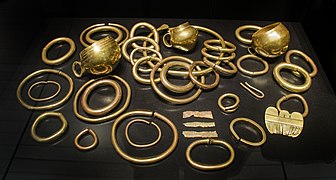
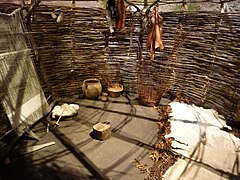

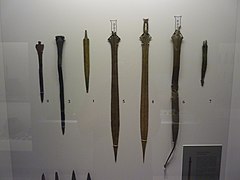

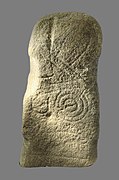





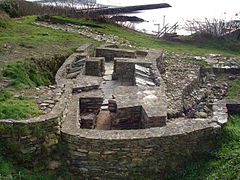





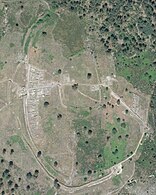









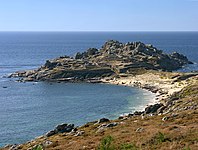

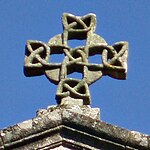
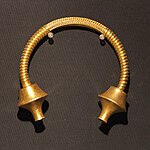

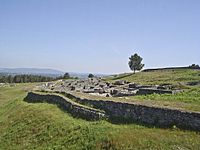
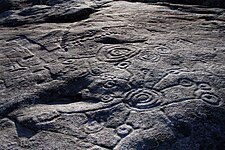




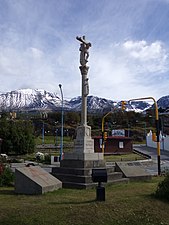

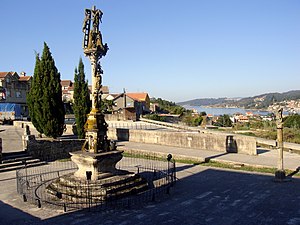
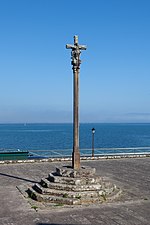




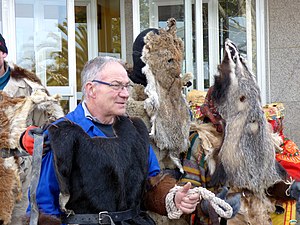


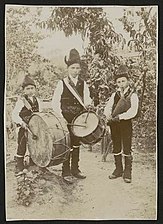
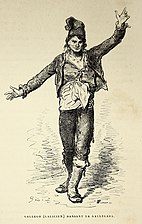





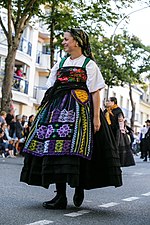

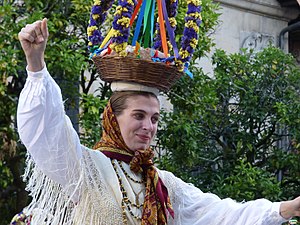
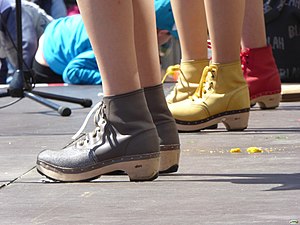
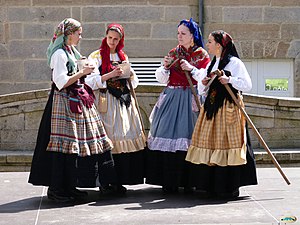
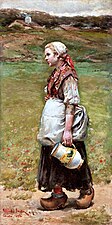



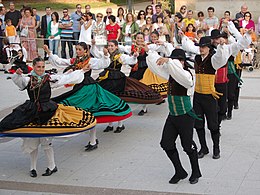
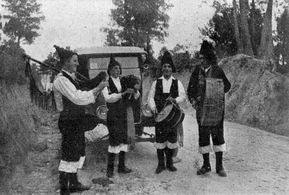



![Eduardo Pondal, considered himself a "bard of freedom", he imagined a Celtic past of freedom and independence, which he tried to recover for Galicia with his poetry.[137]](http://upload.wikimedia.org/wikipedia/commons/thumb/f/fc/Eduardopondal.jpg/77px-Eduardopondal.jpg)














![Ana Peleteiro is a triple jumper and the current national record holder. She won the gold medal in the 2019 European Athletics Indoor Championships.[138]](http://upload.wikimedia.org/wikipedia/commons/thumb/e/e5/Ana_Peleteiro_Glasgow_2019.jpg/93px-Ana_Peleteiro_Glasgow_2019.jpg)








